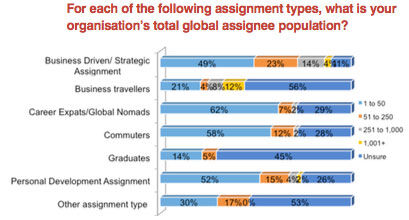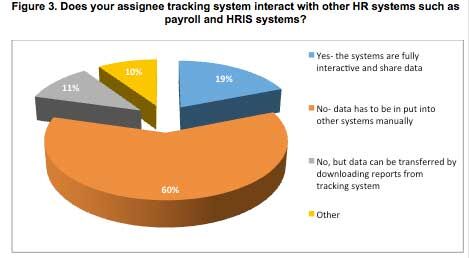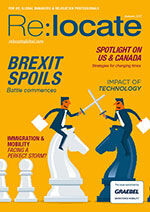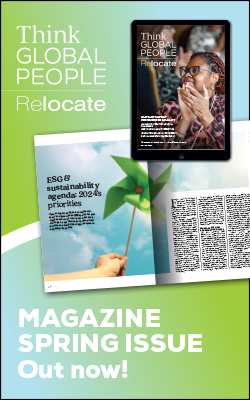Global mobility programmes and compliance: latest trends
Drawing on research among multinationals across a range of sectors, Cranfield University’s Professor Michael Dickmann and the RES Forum’s Andrea Piacentini explore current mobility programme trends.


Support from centres of expertise
Three-quarters of all respondents had a GM centre of expertise (CoE). CoEs support globally standardised processes, enabling cross-border coordination and integration.In RES Forum annual reports from previous years (2014 and 2015), it was argued that GM departments were moving towards becoming more strategic. They were broadening their scope and moving towards a clearer delineation of roles as well as more value-add and consulting activities.A CoE structure may facilitate these developments, as it may be seen as a move towards professionalisation and cost saving, while freeing up key GM staff for more strategic work.The remits of GM CoEs vary but cover a large number of activities. Whilst 96 per cent undertake GM policy-writing and management, the management of compensation and salary reviews (43 per cent) is less frequently within the GM function’s remit. The definition of the GM function’s role will also have an influence on what activities may be outsourced and whether external vendors will cooperate on a local, regional or global level.Outsourcing activities and challenges
Sixty-nine per cent of responding companies predominantly insource their GM work. Of these, 49 per cent have a global structure in which one HR service centre manages GM activities, and 31 per cent work through several regional hubs or service centres. Only 18 per cent have a polycentric structure in which GM is managed and executed locally.It is interesting to note that, where GM is managed in house, the international mobility approach is less integrated than it is for the sample overall. About 12 per cent more of the companies that manage GM in house have a polycentric structure, and 15 per cent more firms have a regiocentric structure than indicated in the answers for the whole sample.This is likely to indicate that companies that are insourcing probably still have efficiency gains to be realised through higher degrees of standardisation and integration (Dickmann, 2017; Bartlett and Ghoshal, 1999).Sixteen per cent are currently considering, and 11 per cent would be open to considering, a move from insourcing to outsourcing. Overall, however, almost all firms rely on outsourcing to some degree. The key services that are being bought are:- Tax service provision
- Household goods shipment
- Destination services, such as home and/or school search
- Immigration provision
- Language lessons
- Intercultural training
- Retain in-house control (27 per cent)
- Support assignees better (27 per cent)
- Capitalise on existing knowledge within the organisation, thus allowing the running of large parts of GM with the support of vendors for only a few specific services (23 per cent)
Related news:
What is important for firms when working with outsourcing providers? During an outsourcing relationship, the price charged has the lowest importance for companies. Instead, the outsourcing provider needs to demonstrate that it has excellent knowledge and skills, cooperates well with the company’s staff, is flexible and able to react to non-standard requirements well, and is accountable.
Which services are outsourced?
Personal tax compliance is almost always outsourced (94 per cent), with immigration and social security compliance work often outsourced (58 per cent) or conducted as a mix of outsourcing and in-house work (34 per cent for immigration and 22 per cent for social security).The most likely areas of total in-house provision are expat payroll (50 per cent) and corporate tax (43 per cent) compliance work. Companies are eager to work with external vendors where they lack know-how or expect legal regulations to change quite rapidly.Assignee tracking and management
Owing to the regulatory frameworks in different countries and the associated risk of falling foul of them, assignee tracking is highly important to responding organisations.Given the number of large firms in our sample that have extremely sizeable assignee populations, as the chart below shows, it is surprising that only 19 per cent have a fully interactive assignee tracking system and 60 per cent have to input data into other systems manually if they want to use them for management decision-making. Beyond risk exposure, better implementation of information technology systems could lead to greater efficiency gains.The RES Forum wanted to know whether firms had a clear picture at all times of their exact assignee population, including where assignees were located.The answer was sobering, in that only a quarter claimed that their tracking system was accurate. A further 59 per cent stated that they believed their system to be reasonably accurate, while 16 per cent of respondents admitted that their organisations’ reporting systems were not accurate. This exposes companies to compliance risks, and may also endanger individuals and the reputation of the organisation in case of a humanitarian or natural disaster or a terrorist attack that requires a guided and rapid corporate response.
Beyond risk exposure, better implementation of information technology systems could lead to greater efficiency gains.The RES Forum wanted to know whether firms had a clear picture at all times of their exact assignee population, including where assignees were located.The answer was sobering, in that only a quarter claimed that their tracking system was accurate. A further 59 per cent stated that they believed their system to be reasonably accurate, while 16 per cent of respondents admitted that their organisations’ reporting systems were not accurate. This exposes companies to compliance risks, and may also endanger individuals and the reputation of the organisation in case of a humanitarian or natural disaster or a terrorist attack that requires a guided and rapid corporate response.For more on assignee tracking and its importance, see these related articles in the Autumn 2017 issue of Relocate magazine:
- Global mobility and immigration facing perfect storm: GXP Summit
- Serviced apartments: fast forward?
- Technology in the workplace: supporting global mobility
Expatriation versus frequent business travel
Current research has proved that both self-initiated and company-sponsored expatriates gain substantially over the long term from working abroad.Returnees felt that, even 12 years after their assignments had ended, their knowledge, skills, abilities, networks, personal insights and motivations, as well as their internal and external marketability, had been strengthened by their global work (Dickmann et al., 2016; Suutari et al., in press).Welch and Worm (2006), as well as Baruch et al. (2013), argue that frequent business travellers can gain many advantages from their international work, but that there are also many drawbacks to this type of working pattern.Those organisations that encourage these professionals to travel in the light of their responsibilities in several countries are under an obligation to manage immigration and social security requirements. For this, efficient and error-free tracking of international business travellers is needed.Companies use a number of different ways to track their business travellers. Data from corporate travel providers is the most popular way to track ‘frequent flyers’, but notifications from the business units, the employee and the tax provider, through in-house tracking tools or from the company’s security team, are also often used.However, the fact that 42 per cent of respondents’ companies do not track their regular business travellers is truly astonishing. As one survey respondent put it, “Oh boy, do we need to do this.”Programme management and compliance is the backbone of successful GM functions. It allows organisations to draw up an efficient GM programme and manage the risks to individuals and the company alike. Organisations of today ignore this at their peril.ReferencesBartlett, C.A. and Ghoshal, S. (1999). Managing across borders: The transnational solution (Vol. 2). Boston, MA: Harvard Business School Press.Baruch, Y., Dickmann, M., Altman, Y. and Bournois, F. (2013). Exploring International Work: Types and Dimensions of Global Careers, The International Journal of Human Resource Management, Special Issue on International HRM. Vol 24(12): 2369–2393.
Dickmann, M. (2017). International Human Resource Management, in T. Redman and A. Wilkinson Contemporary Human Resource Management, pp. 258–292, 5th Edition, London: Prentice Hall.
Dickmann, M., Suutari, V., Brewster, C., Mäkelä, L., Tanskanen, J. and Tornikoski, C. (2016). The career competencies of self-initiated and assigned expatriates: Assessing the development of career capital over time. The International Journal of Human Resource Management, published online 4 May 2016.
RES Forum Annual Reports 2014, 2015, 2016 authored by Michael Dickmann
RES Forum Survey – 'Programme Management and Compliance', Dec 2016, 65 responses
Suutari, V., Brewster, C., Mäkelä, L., Dickmann, M. and Tornikoski, C. (in press). The effect of international work experience on the career success of expatriates: a comparison of assigned and self-initiated expatriates, Human Resource Management.
Welch, D.E. and Worm, V. (2006). International business travellers: a challenge for IHRM. In: Stahl, G.K. and Björkman, I. (eds.), Handbook of Research in International Human Resource Management, pp. 283–300. Cheltenham: Edward Elgar.

 Get access to our free Global Mobility Toolkit
Get access to our free Global Mobility Toolkit  © 2017. This article first appeared in the Autumn 2017 edition of Relocate magazine, published by Profile Locations, Spray Hill, Hastings Road, Lamberhurst, Kent TN3 8JB. All rights reserved. This publication (or any part thereof) may not be reproduced in any form without the prior written permission of Profile Locations. Profile Locations accepts no liability for the accuracy of the contents or any opinions expressed herein.
© 2017. This article first appeared in the Autumn 2017 edition of Relocate magazine, published by Profile Locations, Spray Hill, Hastings Road, Lamberhurst, Kent TN3 8JB. All rights reserved. This publication (or any part thereof) may not be reproduced in any form without the prior written permission of Profile Locations. Profile Locations accepts no liability for the accuracy of the contents or any opinions expressed herein.



























